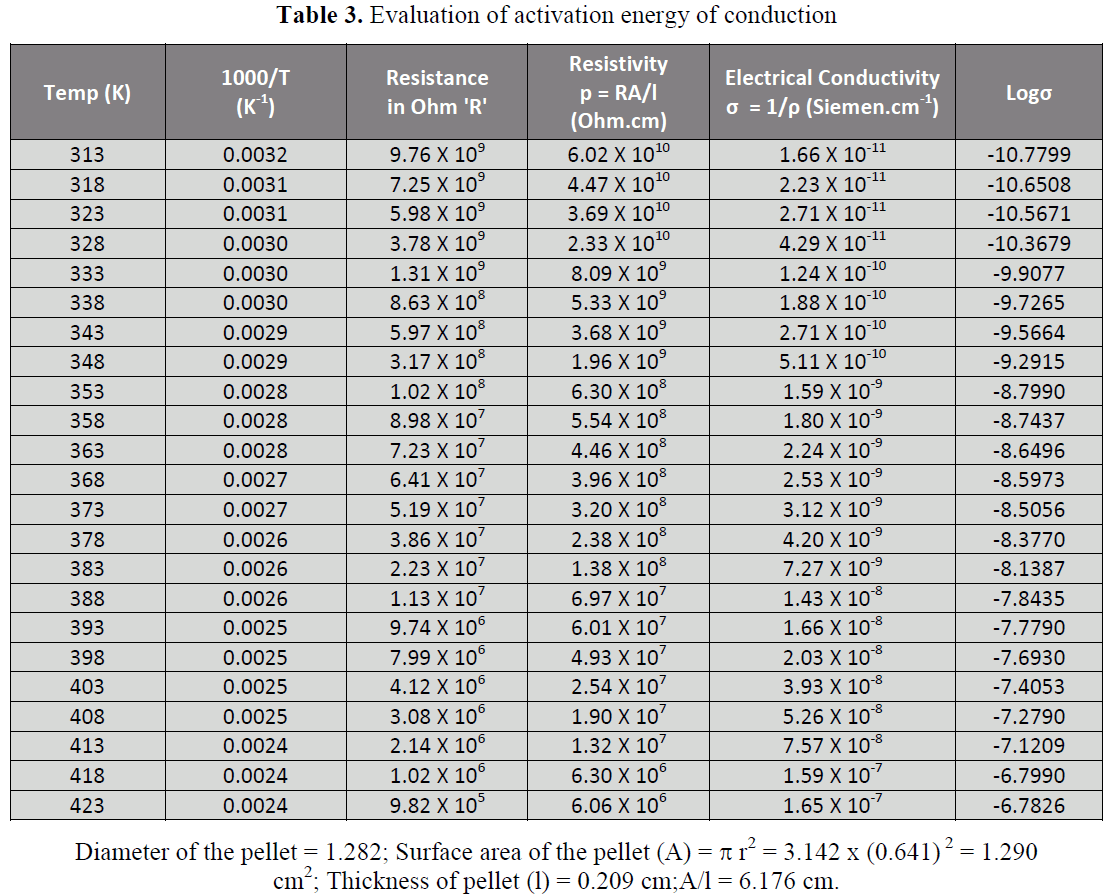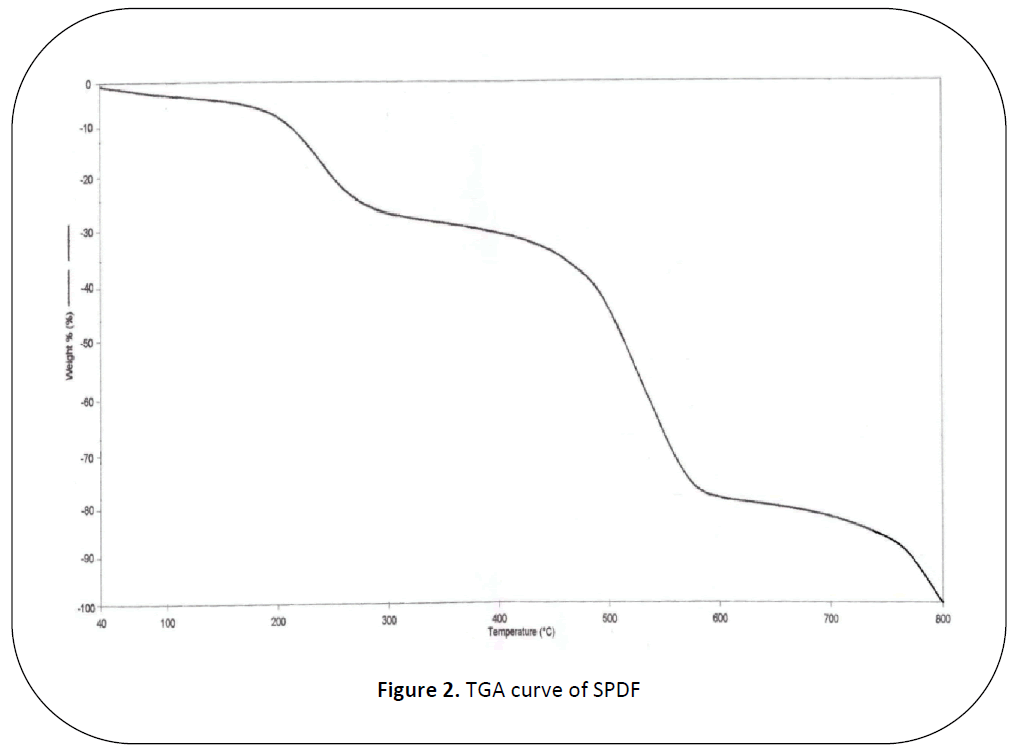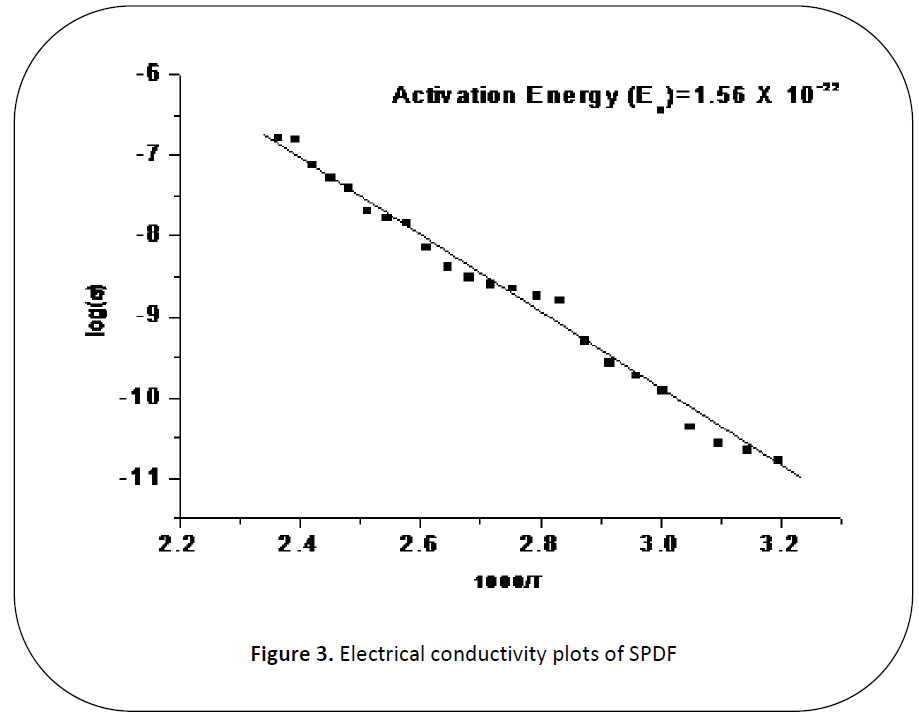Keywords
Resin, Condensation, Thermal stability, Decomposition, Electrical conductivity
Introduction
The advancement in the field resins
has been awfully fast, as they normally
obliging in packaging, adhesives and
coatings in electrical sensors and
organometallic semiconductors [1-4]. The reins
tenders novelty and versatility; hence they have occupied the crucial site in the field of
material science. A phenol group based
resins have a large number of convenient
applications in electronic controls, insulating
materials, protective adhesives, aerospace
industries, etc. because of their high thermal stability, heat and chemical resistance and
electrical insulation properties5-12.
Semiconductors are the vital ingredients of
contemporary electronics. The concerted
research endeavors have been approved for
mounting organic materials that would
possesses superior electrical properties as
the inorganic semiconductors. The prime
attention was positioned on the synthesis of
highly conductive polymers, preferably of
high molecular weight and the measurement
of their electronic conductivity properties,
i.e. conductivity, mobility, thermo-electric
power, etc. The resins have been identified
for their recital as semiconductors while
carrier mobility in them frequently is
actuallittle [13-18]. Kand A et al [19,20] described
the rubeanato-copper semi-conductive
polymers and deliberate their AC and DC
conductivity. Dhawan and coworkers [21]
testified the conducting polymers forecast to
be the revolutionary materials for the
progress of light emitting diodes, antistatic
and EMI materials, sensors, Opto-electronic
devices and rechargeable batteries owing to
their brilliant conduction mechanism and
superior environmental consultancy. The
Freeman–Carroll and Sharp-Wentworth
methods have been pragmatic for the
cunning of kinetic parameters [22-24].
Approaches for the assessment of kinetic
parameters from thermogravimetric readings
are customarily grounded on the supposition
to the Arrhenius equation are substantial
with thermal and diffusion barriers are
insignificant. For the electrical conductivity
measurement study the DC resistance of the
SPDF resin had been measured by smearing
a constant voltage (50 volts) across the
pellets. The temperature reliance of the
electrical conductivity of the resin is then
plotted. The energy of activation (Ea) of
electrical conduction calculated from the
slopes of the plots. The electrical
conductivity of the resin had been studied
with a rise in temperature.
Experimental Section
Chemicals
All Chemicals had been applied are of
AR grade. Salicylic acid, Phenylenediamine
has been purchased from Aldrich Chemical
Co., USA and Formaldehyde from LOBO
Chem., India, DMF and DMSO (HPLC
grade) were used.
Instruments used
Thermogravimetric analyses (TGA)
of the resin sample had been approved by
Perkins Elmer TGS-ll thermal analyzer at a
heating rate of 10°C per minute in air
atmosphere upto 800°C. The thermogram had
been noted as Sophisticated Instrumentation
Centre for Applied Research and Testing
(SICART), Vallabh Vidyanagar, Gujrat,
India. The electrical resistivity of the resin
had been designed by Hewlett-Packard 4192
Impedance analyzer 5Hz-13MHz at
Department of Physics, RTM Nagpur
University, Nagpur over a wide range of
temperature of 313-423 K.
Synthesis and characterization of SPDF
resin
A combination of salicylic acid,
phenylenediamine and formaldehyde in the
molar proportion 1:1:2 with hydrochloric acid
as catalyst had been animated in an oil bath at
120°C for 7 hours. The resinous product had
been dehydrated in the air and crushed with
mortar and pestle. The product had been
extracted with diethyl ether and petroleum
ether to eradicate salicylic acidphenylenediamine
and copolymers that might
be present with the resin. It was further
purified by dissolving in 8% sodium
hydroxide solution, reprecipited by the steady
drop wise addition of 1:1 (v/v) hydrochloric
acid by normal stirring to shun lump
formation [22-26]. The resin was filtered and
purity checked with thin layer
chromatography method. The resin is soluble
in DMF, DMSO. However, it was insoluble in acids and common organic solvents. Our
manuscript [27] reveals the characterization of
resin by elemental analysis, infrared (IR)
spectroscopy, nuclear magnetic resonance
(NMR) spectroscopy and UV- Visible
spectral studies. The number average
molecular weight of the resin had been
determined by non-aqueous conductometric
titration.
The structure of newly synthesized
resin has been specified underneath (Figure 1).
Figure 1: Synthesis of SPDF
Thermogravimetry
Thermal analysis progression was
correlated through a transform in weight with
reverence to temperature. Heating was
performed under firmly proscribed
circumstances and could divulge changes in
arrangement and other vital properties of the
material being studied (Table 1). In dynamic
TGA the sample is subjected to circumstances
augment in temperature at linear pace [28,29].
Table 1: Thermo analytical facts and decomposition temperature of SPDF
The benefit of Freeman and Carroll
technique was that in a single step by keeping
the heating rate steady the order of reaction
and energy of activation could be calculated
in a sole experiment. The subsequent equation
had been applied to estimate diverse kinetic
parameters (Table 2):
Table 2: Kinetic parameters of SPDF

Consequently, a plot of  should bid a
straight line with an intercept on y-axis
identical to the value of n (the order of
reaction) and the slope m = E / 2.303R.
should bid a
straight line with an intercept on y-axis
identical to the value of n (the order of
reaction) and the slope m = E / 2.303R.
Where,
dw/dt= rate of change of weight with
time and in expression Wr = Wc –w,
Wc= weight loss at the completion of
the reaction, w is the total weight loss up to
the time t and T is the temperature in k.
The following expression is used to
evaluate Ea with Sharp- Wentworth method:

Where,
dc/dt = the rate of change of mass
with time t, T is the temperature and β=
ΔT/dt.
Electrical conductivity
The resins are recognized for their
performance as semiconductors though carrier
mobility in them is awfully low. This is
owing to the complexity which electrons
experience in jumping from one molecule to
another. Thus the carrier mobility in
compounds of these sort increases with the
rise in molecular size [16-20,28-31].
Resin had been palatalized
isostatically in a steel die at 10 tonnes/2inch
with a hydraulic press. A thin layer of
colloidal graphite which functions as
electrode had been applied on both sides of
the pellets in acetone and desiccated at room
temperature for 6 hours. The average
diameter of this pellet and its thickness were
calculated with Screw Gauze. The
temperature variations of resin were studied
by placing the sample holder along with the
pallet in the electric furnace that was then
heated slowly. The slow rate of heating 1 to
10°C per minute was maintained throughout
the investigation. The resistances of the
sample pallets were measured by two probes
(terminals) method.
Resistivity (ρ) was then calculated
using the relation: ρ = R. x A/l.
Where, R= resistance of the pellet; A
= Surface area of pellets & l = Thickness of
pellet.
The DC resistivities were measured
from 313 to 423 K. The electrical
conductivity (σ) varies exponentially with the
absolute temperature according to the wellknown
relationship.

Where,
σ=electrical conductivity (T); σ0=
electrical conductivity; Ea =Activation energy
of electrical conduction; K= Boltzmann
constant; T= Absolute temperature.
The relationship has been modified as:
Log σ = logσ0 + -Ea/2.303kT.
Rendering to this equation, a plot of
Log σ Vs 1/T would be linear with negative
slope (Figure 3). From the Slope of the plots, the
activation energy was calculated (Table 3). [12-16,28-31].
Table 3: Evaluation of activation energy of conduction
Results and Discussion
Thermal degradation study for SPDF resin
Thermal degradation curve for SPDF
resin was revealed in Figure 2 exhibits a fourstage
decay and its ranges were given in Table 1.The first phase decay, which was
unhurried and reached from 40-210oC
agreeing to lose 5.8% which may be due to
entrapped H2O fragment. The second step
decay signifies deprivation of -OH and -
COOH group. The pragmatic mass loss is
22.5%. The third stage putrefaction is due to
the loss of adjacent shackle phenolic -OH
group and observed 68.5%. The fourth state
decomposition resembles to total breakdown
of the resin. The Half Decomposition
temperature of SPDF resin was originated to
be 225°C.
Figure 2: TGA curve of SPDF
As per thermogram activation energy
deduced with Freeman – Carroll and Sharp-
Wentworth approaches were in fine accord
with each other. Thermodynamic parameters
had been calculated on the origin of thermal
activation energy and standards were
quantified in Table 2. Due to the abnormally
little value of frequency factor [Z] it may be
classified as a dawdling reaction. The
assessment of entropy [ΔS] indicates the
activated polymer had additional ordered
assembly than the reactants. This was further
braced by low Z values [22-25,28-32]. It was
awfully complicated to depict any elite
inference from the magnitude of thermal
activation energy [Ea] as disintegration mechanism was expected to be complicated.
Positive values of activation energy present
examination connect the energy of activation
due oxidation–reduction process of resin in
the higher temperature range [22-24,28-32]. This
was expected, since, the decomposition of the
resin was not obeying first order kinetics
perfectly. These clarifications are in accord
with the assumption of Jacobs and Tompkin
and other previous researchers [33].
Electrical conductivity of SPDF resin
The significances of electrical
conductivity and activation energy were
integrated in Table 3. The temperature
dependence of the electrical conductivity of
the resin was revealed in Figure 3. The electrical
conduction of polymeric material depends
upon inestimable parameters such as porosity,
pressure, method of preparation, ambiance
etc; activation energy (Ea) was not affected
by these parameters and, therefore, it was
rather reproducible [22,24,34-37]. The extent of
activation energy depends on the number of
electrons existing in semiconductor
ingredients. The low degree of activation
energy may owe to companies of more
amounts of Л-electrons in the chain. This was
in good promise with the most practicable
organization anticipated for the newly
blended resin under exploration [12-16]. The
carrier motilities of the organic
semiconductors might decrease due to:
Figure 3: Electrical conductivity plots of SPDF
• The forces between the adjacent
molecules are comparatively weak as
organic compounds from molecular
crystals.
• Due to modest electronic coupling that
exists among the contiguous molecules, it
becomes difficult for the electrons to hop
from one molecule to another.
• As an effect of the tangled configuration
which is due to amorphous nature, the
electrons get speckled while itinerant
through the materials, when they attempt to stream through it and hence lower the
conductivity.
The study shows the following results
of electrical conductivity-
• The electrical conductivity of the SPDF
resin at room temperature lies in the range
of 2.29 x10-11 to 2.36x10-7 Siemen.
• The plots of log (versus 1/T were found
to be linear in the temperature range under
study, which indicate that the Wilson’s
exponential law (= (o exp (ΔE/kT) is
obeyed.
• The energy of activation (Ea) of electrical
conduction calculated from the slopes of
the plots was found to be in the range of
1.59 x 10-22 J/K.
These remarks and domino effect
were in harmony with the conclusion of
former workers [12-16,22,24,34-37]. Electrical
conductivity of each of the resin increases to
rise in temperature. Hence, the resin may be
ranked as semiconductors.
Acknowledgment
The authors are grateful to the Head,
Department of Chemistry, Rashtrasant
Tukadoji Maharaj Nagpur University, Nagpur
for providing essential laboratory services.
References
- Coppo P., Schroeder R., Grell M., Turner M.L.; Investigation of the electronic properties of cyclopentadithiophene polymers and copolymers Materials Research Society Symposium Proceedings 771 (Organic and Polymeric Materials and Devices), CODEN: MRSPDH; ISSN: 2003, 0272-9172, 61- 64.
- Kang S.W., Kim J.H., Oh K.S., Won J.; Effect of amino acids in polymer/silver salt complex membranes on facilitated olefin transport. J. of Membrane Sc., 2004; 248: 201–206.
- Nezel T., Fakler A., Zhylyak G., Mohr G.J., Keller S.; A highly sensitive NO2- selective optode membrane, Sensors and Actuators B, 2000;70:165–169.
- Coppo P., Grell M., Turner M.L.; Cyclopentadithiophene based electroactive materials; J. Mater. Chem., 2005, 15: 1123–1133.
- Colin F. P., Rena M. P.; Thermally stable, highly fluorinated stationary phases for gas chromatography, Analytica Chimica Acta; 1987; 200:151- 169.
- Chandra R., Rajabi L., Soni R. K.; The effect of bismaleimide resin on curing kinetics of epoxy-amine thermosets, J. of Appl. Polym. Sc.; 1996; 62, 4:661-671.
- Masram D.T.; Thermal Degradation Study of Terpolymer Resin derived from Salicylic acid, Diaminonaphthalein, Formaldehyde Terpolymer, E- J. of Chemistry; 2009; 6(3):830-834.
- Das A.P.; S. Lenka; Nayak P.L.; Synthetic resins: I. Preparation and characterization of resins from substituted benzoic acid-formaldehyde, J. Appl. Polym. Sci. 1985; 30:4619.
- Aristove L.J.; Kostantinov V.V.; Polymers with chelate bonding, derived from 8-quinolinol.; Izu. Tomsk. Politekhn. Inst.; 1961; 111: 104-6.
- Samal R.K., Senapati B.K., Behuray T.B.; Synthesis and Characterization of Aniline-Doped Mixed Copolymer Resins-2., J. Appl. Polym. Sci.; 1996; 62 :655.
- DeGeiso R.C.; Donaruma L.G.; Tomic, E A., Polymeric Ligands, Separation of Uranium from Solutions and Ore Leaches with Salicylic Acid- Formaldehyde Polymers, Ind. Eng. Chem. Process Des. Dev., ACSpub.; 1963; 2 (1):43–44.
- Masram D.T., Kariya K.P., Bhave N.S.; Thermal degradation and electrical conductivity measurement study of resin derived from salicylic acid, hexamethylenediamine and formaldehyde” Elixir Appl. Chem. 2012, 48, 9557- 9562., ISSN 2229-712X.
- Masram D.T., Kariya K.P., Bhave N.S.; Kinetics of Thermal Degradation Study of Resin derived from Salicylaldehyde, Ethylenediamine and Formaldehyde; EJ. of Chemistry; 2010;7(2), 564- 568.
- Ozawa T.; Applicability of Friedman Plot; J. Thermal Analysis; 1986; 3l: 547- 551.
- Manvalan R.; Patel M.M.; Synthesis and Study of Tercopolymers; J. Macromolecular Chem.; 1983; A-20 (9): 907-925.
- TalatiA. M and Mistry V.N.; Semiconducting chelate polymers of dihydroxyquinones with cobalt Polymères semi-conducteurs de chélate par les dihydroxy-quinones avec le cobalt Halbleitende spheron polymer von dihydroxy-chinonenmitkobalt. Materials Sc. and Eng.; 1972; 10: 287- 290.
- Han G., Shi G.; Porous polypyrrole/ poly methyl methacrylate composite film prepared by vapor deposition polymerization of pyrrole and its application for ammonia detection. Thin Solid Films; 2007; 515, 17: 6986-699.
- Kharadi G.J.; Panchani S.C.; Patel K.; D. Studies on Some Coordination Polymeric Chains of Metal Ions with QM1N. International Journal of Polymeric Materials; 2010; 59, 8, 577 - 587.
- Kanda S., Kawaguchi S.; Electrical conductivity of some coordination polymers. J. Chem. Physics; 1961; 34; 1070.
- Kanda S. , Kawaguchi S.; Synthesis of Co-ordination Compounds of High Molecular Weight. Bulletin of the Chemical Society of Japan; 1957; 30, 2: 192-193.
- Dhawan S.,Koul S., Chanda S.; National Seminar on Polymer, Chennai, 24, 1996.
- Masram D.T., Kariya K.P., Bhave N.S.; Kinetic and Electrical Conductivity Measurement Study of SDBF Resin” International Journal of Engineering Research, 2013, 2, 2, 165-170, 01, ISSN: 2319-6890.
- Masram D.T., Kariya K.P., Bhave N.S.; Synthesis, characterization and thermal degradation study of terpolymer derived from p-hydroxybenzoic acid, diaminonaphthalene with formaldehyde, High Perform. Polym.; 2010; 22, 8:1004 -1016.
- Masram D.T., Kariya K.P., Bhave N.S.; Thermal degradation and electrical conductivity measurement study of resin derived from salicylic acid, hexamethylenediamine and formaldehyde” Elixir Appl. Chem. 2012, 48, 9557- 9562., ISSN 2229-712X.
- Jadhao M.M., Paliwal L.J., Bhave N. S.; Resin I: Synthesis and characterization of 2, 2 -dihydroxybiphenyl-ureaformaldehyde terpolymers, J. Appl. Polym. Sci.; 2005, 96, 5; 1605 - 1610.
- Masram D.T., Kariya K.P., Bhave N.S.; Synthesis of Resin-I: Salicylic acid hexamethylenediamine and Formaldehyde and its ion exchange properties, Epolymers; 2007; ISSN 1618-7229, 75.
- Masram D.T., Kariya K.P., Bhave N.S.; Analytical Applications of Newly Synthesized Resin Derived From Salicylic Acid, Phenylenediamine And Formaldehyde” Der Pharma Chemica, Scholars Research Library, 2012, 4, (3): 1239-1246 ISSN 0975-413X.
- Freeman E.S., Carroll B.J.; The Application of Thermoanalytical Techniques to Reaction Kinetics: The Thermogravimetric Evaluation of the Kinetics of the Decomposition of Calcium Oxalate Monohydrate,; Phys. Chem. 1958, 62, 4, : 394–397.
- Freeman E.S., Anderson D.A.; The kinetics of the thermal degradation of polystyrene and polyethylene, J. Polym.; 1961; 54, 159:253 – 260.
- Sharp J.B.; Wentworth S.A.; Kinetic analysis of thermogravimetric, Anal. Chem. 1969; 41 (14): 2060–2062.
- Coats A.W.; Redfen J.P.; Kinetic parameters from thermogravimetric data. II; J. of Polym. Sc. Part B: Polymer Letters, 2003, 3, 11:917 – 920.
- Ozawa T.; Kinetics of non-isothermal crystallization; J. Thermal Analysis; 1971, 12, 3: 150-158.
- Jacobs P.W.M.; Tompkins F.C.; Chemistry of Solids State, E.G., Garner Publication, London; 1955, 188.
- 34. Azaroff L.V.; Introduction to Solids, McGraw Hill Inc. New york; 1960.
- Dunlop W.V.; An introduction to semiconductors, Wiley, New York,; 1957, 189.
- Fanun M.; Conductivity, viscosity, NMR and diclofenac solubilization capacity studies of mixed nonionic surfactants microemulsions. J. Molecular Liquids; 2007, 135, 1-3:5-13.
- Masram D.T., Kariya K.P., Bhave N.S.; "Electrical conductivity study of resin synthesized from salicylic acid, butylenediamine and formaldehyde,” Archives of Applied Science Research; 2010, 2(2):153-161.

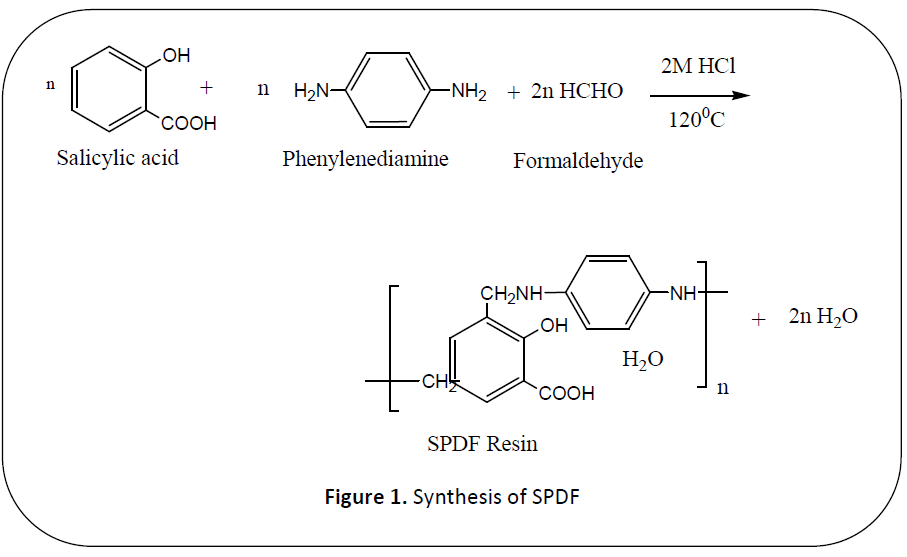
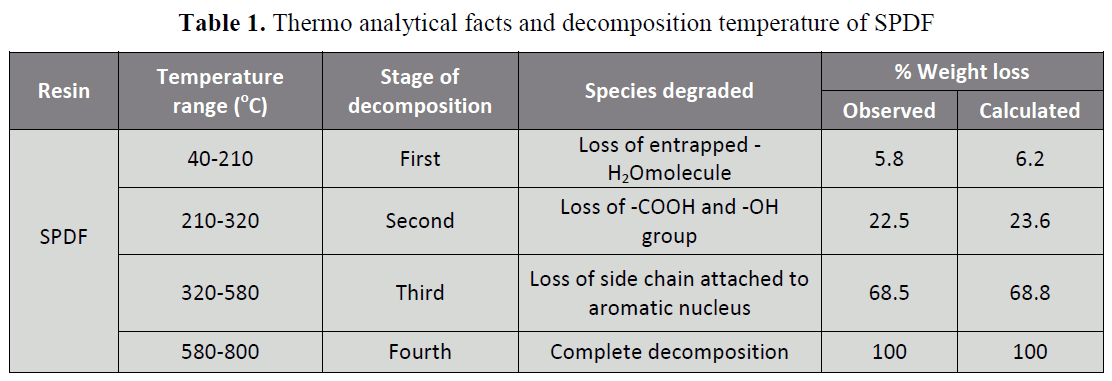


 should bid a
straight line with an intercept on y-axis
identical to the value of n (the order of
reaction) and the slope m = E / 2.303R.
should bid a
straight line with an intercept on y-axis
identical to the value of n (the order of
reaction) and the slope m = E / 2.303R.

